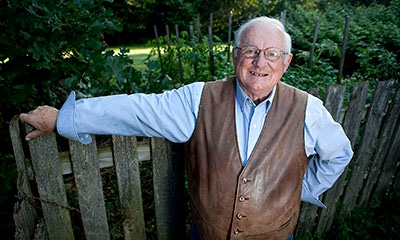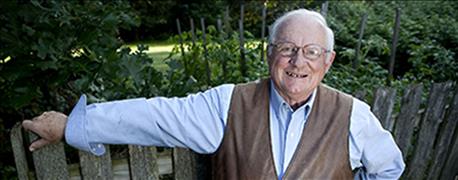
After four years of researching, writing, editing and fact checking, Jerry Apps latest book, "Wisconsin Agriculture: A History," has been published by Wisconsin Historical Society Press.
Apps, who was born and raised on a central Wisconsin dairy farm near Wild Rose, is a former county Extension agent and professor emeritus for the College of Agriculture and Life Sciences at University of Wisconsin-Madison. Today, he works as a rural historian, writer, story teller and creative writing instructor. He and his wife Ruth have three children, seven grandchildren and one great-grandson. They divide their time between their home in Madison and their farm in Waushara County.

Jerry Apps grew up on a farm near Wild Rose and has written 40 books, most about agriculture.
The 81 year old has written more than 40 fiction, non-fiction and children's books with topics ranging from barns and one-room schools to cranberries, cucumbers, cheese factories and farming with horses.
Apps says this book was the most difficult book he has written and the most fun.
"We did the best we could. My frustration is I came up with a lot more information than we could fit in the 320-page book. It was difficult to decide what to include and what to leave out," he explains.
A full history of Wisconsin agriculture has not been published since 1922. So why did Apps take on the daunting task of writing about the state's diverse agriculture history?
"I have been writing about the fringes of Wisconsin agriculture history for years. I've written about cheese factories, horses, electricity and many other aspects of Wisconsin agriculture," Apps explains. "There is a lot of Wisconsin agriculture history that people just don't know.
"A lot of people are unaware that we grew hemp in Wisconsin. We started the first hemp experimental plots in 1908 at University of Wisconsin-Madison. Wisconsin was No. 2 in hemp production behind Kentucky," he says.
Hemp production really took off during World War I and again during World War II for rope production.
"It was also needed for binding small grains bundles," he says. "It was declared illegal to grow hemp in 1970."
~~~PAGE_BREAK_HERE~~~
The early farmers who came to Wisconsin were not immigrants, Apps says.
"The first farmers were from upstate New York," he explained. "They had worn out the land there and came here from 1838 to 1850. They were primarily dairy farmers who came here and they grew wheat. The women milked and fed the cows and made cheese and butter in the kitchen.
"They were followed by an influx of immigrants who migrated here starting in the early 1840s when the Germans began arriving, and enhanced by the Irish Potato famine from 1845 to 1852," he says. "By 1900, we had people from 40 different countries living in Wisconsin. No. 1 was German, No.2 was Norwegian and No. 3 was Irish."
Apps says the period in Wisconsin agriculture history that he finds the most fascinating is from 1870 through 1910.
"Our southern Wisconsin farmers discovered in 1870 that they could no longer profitability grow wheat," he explains. In 1860, Wisconsin was the No. 2 wheat producing state in the nation, but by 1870 yields were greatly diminished.
"This transition started after the Civil War," he says. "It really took off in the late 1870s. By 1910, we officially became the Dairy State producing more milk, cheese and butter than any other state."
California overtook Wisconsin in milk production in 1993, but Wisconsin is still in No. 1 in cheese production.
"It was the influence of W.D. Hoard of how to make a living on this land and the answer was dairy cows," Apps says. "Some of the state's farmers said they liked wheat farming and they moved to Kansas and Nebraska. The ones who stayed behind began dairy farming. Not only did they have trouble switching from wheat to cheese, they had a hard time selling their product. This was not an easy transition."
The second biggest transition came during the Great Depression.
"That's when a number of farmers lost their farms because they could not make their mortgage payments and there were so many years of drought and dust," he says.
The third biggest transition came from 1945 to the 1960s.
~~~PAGE_BREAK_HERE~~~
That's when tractors replaced horses, electricity made it to all farms and the number of farmers dropped dramatically," he says. "Hybrid seed corn and pesticides came around and we did not need as many farmers."
Books available
Apps says the book has been fact checked front to back by the Wisconsin Historical Society. It has a lot of detail and nearly 200 photos. Interest in the book has been tremendous so far. Apps has already been at a number of book talks and book signings around the state including at Wisconsin Farm Technology Days which was held the end of August shortly after the book published.
"Wisconsin Agriculture: A History," which costs $34.95, may be ordered by calling 888-999-1669 or by shopping online at www.wisconsinhistory.org/shop or by shopping at the Wisconsin Historical Museum Shop at 30 N. Carroll St., Madison, WI 53703. Or you can attend one of Apps book signings if you would like your book autographed. Visit his website at jerryapps.com and click on his blog to learn where his next book signings will be held.
Apps to appear in third PBS show
The first television show Jerry Apps did on PBS "Farm Story with Jerry Apps" was televised in 49 states. The second show "Farm Winters with Jerry Apps," won an Emmy and was televised in all 50 states. The third show "The Land with Jerry Apps," will air Dec. 2 on PBS at 7 p.m.
"The Land with Jerry Apps," is one hour and was filmed at his farm in Waushara County.
"It's based on my book 'Whispers and Shadows,'" Apps explains. "It's more of an environmental book which features my two grandsons and I am talking about why it's important to take care of the land."
Apps believes too many kids today play video games all day and don't get outside enough.
"They ought to help garden or go fishing," he says. "If they are outside they will want to take care of the land."
Apps says they spent 20 hours filming "The Land with Jerry Apps," to come up with "the material we needed for a one-hour show," Apps noted. "I hope you enjoy it.
About the Author(s)
You May Also Like






